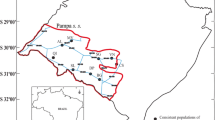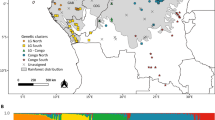Abstract
We have investigated levels of genetic diversity within and among seven remnant populations of Caesalpinia echinata Lam., an endangered species found as fragmented populations in three major areas around the coastal regions of Brazil. Using amplified fragment length polymorphism (AFLP) genetic markers, we detected levels of within-population genetic diversity ranging from 0.092 to 0.163, with the lowest values generally being found in the smallest populations. Estimates of between-population genetic differentiation were strongly correlated with geographical distance (r = 0.884, p < 0.001), which,along with a neighbour-joining phylogenetic analysis, strongly suggested high levels of genetic isolation by distance. Over half (62%) of the total genetic diversity was partitioned between populations, further highlighting the genetic distinctness of individual populations. Taken together, these results suggest that fragmentation has led to an increase in population differentiation between fragments of C. echinata. These formations will be of great value in the development of conservation plans for species exhibiting high levels of genetic differentiation due to fragmentation, such as indication of conservation unit size, which populations should be chosen as priority in conservation plans and which samples should be introduced in areas with a low number of individuals of brazilwood.
Similar content being viewed by others
References
Brasil Portaria n.006/92-N,15 de janeiro de 1992. 1992. Lista Oficial de Espécies da Flora Brasileira Ameaçadas de Extinção. Diário Oficial da República Federativa do Brasil, Brasília, Brazil.
M.A. Cardoso J. Provan W. Powell P.C.G. Ferreira D.E. de Oliveira (1998) ArticleTitleHigh genetic differentiation among remnant populations of the endangered Caesalpinia echinata Lam (Leguminosae Caesalpinioideae) Molecular Ecology 7 601–608
S.R.S. Cardoso N.B. Eloy J. Provan M.A. Cardoso P.C.G. Ferreira (2000) ArticleTitleGenetic differentiation of Euterpe edulis Mart. populations estimated by AFLP analysis Molecular Ecology 9 1753–1760
K.J. Chalmers R. Waugh J.I. Sprent A.J. Simons W. Powell (1992) ArticleTitleDetection of genetic variation between and within populations of Gliricidia sepiumG. maculata using RAPD markers Heredity 69 465–472
M.G. Chung S.S. Kang (1994) ArticleTitleGenetic variation and population structure in Korean populations of Eurya japonica (Theaceae) American Journal of Botany 81 1077–1082
A. Cresswell N.R. Sackville-Hamilton A.K. Roy B.M. Viegas (2001) ArticleTitleUse of amplified fragment length polymorphism markers to assess genetic diversity of Lolium species from Portugal Molecular Ecology 10 229–241
M. Cunha H.C. Lima (1992) Viagem à Terra do Pau Brasil, 1st ed Agência Brasileira de Cultura Rio de Janeiro, Brazil
W. Dean (1996) A ferro e fogo2nd ed Companhia das Letras Rio de JaneiroBrazil
C. Dutech J. Seiter P. Petronelli H.I. Joly P. Jarne (2002) ArticleTitleEvidence of low gene flow in a neotropical clustered tree species in two rainforest stands of French Guiana Molecular Ecology 11 725–738
S. Dayanandan J. Dole K. Bawa R. Kesseli (1999) ArticleTitlePopulation structure delineated with microsatellite markers in fragmented populations of a tropical treeCarapa guianensis (Meliaceae) Molecular Ecology 8 1585–1592
L. Excoffier P. Smouse J. Quattro (1992) ArticleTitleAnalysis of molecular variance inferred from metric distances among DNA haplotypes: application to human mitochondrial DNA restriction data Genetics 131 479–491
Fauna and Flora International, Jardim Botânico do Rio de JaneiroFundação Botânica Margaret Mee. 1997. Conservação e manejo de pau brasil (Caesalpinia echinata Lam.). Plano de açãoBúzios, Brazil.
J. Felsenstein (1995) PHYLIP (Phylogeny Inference Package), Version 3.57c. Department of Genetics University of Washington Seattle, Washington
A.C. Gillies C. Navarro A.J. Lowe A.C. Newton M. Hernandez J. Wilson J.P. Cornelius (1999) ArticleTitleGenetic diversity in mesoamerican populations of mahogany (Swietenia macrophylla), assessed using RAPDs Heredity 83 722–732
J.L. Hamrick (1989) Isozymes and the analysis of genetic structure in plant populations D.E. Soltis P.S. Soltis (Eds) Plant Biology Dioscorides Press PortlandOregon 87–105
D.R. Huff R. Peakall P.E. Smouse (1993) ArticleTitleRAPD variation within and among natural populations of outcrossing buffalograss [Buchloe dactyloides (Nutt.) Engelm.] Theoretical and Applied Genetics 86 927–934
L.F. Keller D.M. Waller (2002) ArticleTitleInbreeding effects in wild populations Trends in Ecology and Evolution 17 230–241
C.F. Lira S.R.S. Cardoso P.C.G. Ferreira M.A. Cardoso J. Provan (2003) ArticleTitleLong term population isolation in the endangered tropical tree species revealed by chloroplast microsatellites Molecular Ecology 12 3219–3225
G.M. Muluvi J.I. Sprent N. Soranzo J. Provan D. Odee G. Folkard W. Powell (1999) ArticleTitleAmplified fragment length polymorphism (AFLP) analysis of genetic variation in Moringa oleifera Lam Molecular Ecology 8 463–470
M. Nei (1978) ArticleTitleEstimation of average heterozigosity and genetic distances from a small number of individual Genetics 89 583–590
M. Nei (1987) Molecular Evolutionary Genetics Columbia University Press New York
K. Obayashi Y. Tsumura T. Ihara-Ujino K. Niiyama H. Tanouchi Y. Suyama et al. (2002) ArticleTitleGenetic diversity and outcrossing rate between undisturbed and selectively logged forests of Shorea curtisii (Dipterocarpaceae) using microsatellite DNA analysis International Journal of Plant Science 163 151–158
S.W. Pacala C.D. Canham J. Saponara J.A. Silander SuffixJr. R.K. Kobe E. Ribbens (1996) ArticleTitleForest models defined by field measurements: estimation, error analysis and dynamics Ecological Monographs 66 1–43
R.D.M Page (1996) ArticleTitleTreeView: an application to display phylogenetic trees on personal computers Computational and Applied Biosciences 12 357–358
P.J. Rodrigues (1998) Efeito da fragmentação e degradação do ambiente na estrutura e demografia de sub-populações de Caesalpinia echinata Lam Universidade Federal do Rio de Janeiro Brazil
J.R. Russell J.C. Weber A. Booth W. Powell C. Soltelo-Montes I.K. Dawson (1999) ArticleTitleGenetic variation Calycophylum spruceanum in the Peruvian Amazon Basin revealed by amplified fragment length polymorphism (AFLP) analysis Molecular Ecology 8 199–204
S. Schneider D. Roessli L. Excoffier (2000) ARLEQUIN Version 2: Software for population genetic data analysis Genetics and Biometry Laboratory. University of Geneva Switzerland
Y. Suyama K. Obayashi I. Hayashi (2000) ArticleTitleClonal structure in a dwarf bamboo (Sasa senanesis) populations inferred from amplified fragment length polymorphism (AFLP) fingerprints Molecular Ecology 9 901–906
S.E. Travis J. Maschinski P. Keim (1996) ArticleTitleAn analysis of genetic variation in Astralagus cremnophylax var. cremnophylax; a critically endangered plantusing AFLP markers Molecular Ecology 5 735–745
P. Vos R. Hogers M. Bleeker M. Reijans T. de Lee M. Hornes et al. (1995) ArticleTitleAFLP: a new technique for DNA fingerprinting Nucleic Acids Research 23 4407–4414
G.M. White D.H. Boshier W. Powell (2002) ArticleTitleIncreased pollen flow counteracts fragmentation in a tropical dry forest: an example from Swietenia humilis Zuccarini Proceedings of the National Academy of Sciences USA 99 2038–2042
F.C. Yeh R.C. Yang T. Boyle (1997) POPGENEVersion 1.21: Software Microsoft Window-based Freeware for Population Genetic Analysis University of Alberta Edmonton, Alberta, Canada
Author information
Authors and Affiliations
Corresponding author
Rights and permissions
About this article
Cite this article
Cardoso, S.R.S., Provan, J., Lira, C.D.F. et al. High levels of genetic structuring as a result of population fragmentation in the tropical tree species Caesalpinia echinata Lam.. Biodivers Conserv 14, 1047–1057 (2005). https://doi.org/10.1007/s10531-004-8409-z
Received:
Accepted:
Issue Date:
DOI: https://doi.org/10.1007/s10531-004-8409-z




